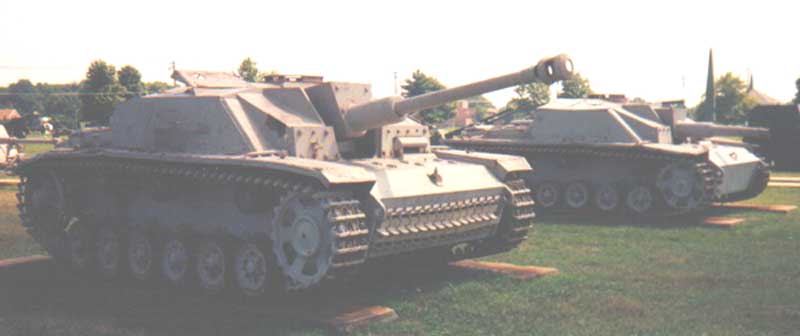|
|
|
Stug III Ausf G
Stug III Ausf G

STRUMGESCHÜLZ
When considering reasons for the success of the German's panzer arm, the Stug III should come to mind as a major factor. Especially being that it was originally designed as an infantry support weapon. Built on a panzer III chassis, the theory of it's use proved highly successful when they were available in limited numbers for the German invasion of France in 1940. Leading the charge with the infantry, they could destroy enemy strong points with their low valocity 75mm gun at pointblank range saving German casualties.
However, it's short barreled low volicity gun was inadequate against enemy tanks due to the fact it could only knock them out at close range. The invasion of the Soviet Union in the summer of 1941 proved this clearly. The Germans quickly corrected this by late 1941 with the mounting of a more powerful, long barreled 75mm gun. This version was the Stug III Ausf. F which was also up armoured from 50mm to 80mm. Some Ausf. F models mounted a 105mm howitzer as well as the next variant, the Ausf. G, which was the last production assault version built.
With all the constant improvements made to the Stug III, it remained a formidable weapon up to the war's end. 7,720 Ausf. Gs were produced and well over 9,000 in all, counting variants. Some versions were; command vehicles, ammo carriers, some carried bridging material and in the summer of 1943 a flame-thrower version entered service designated the Stug (F1).

|
Specifications of the | |
WEIGHT | 23.5 Tons |
|---|---|
CREW | 4 |
ARMAMENT | 75mm & 2 mgs |
ARMOUR | 80mm (3.14in) |
ENGINE | Maybach HL120TRM |
SPEED | 40km/h (25mph) |
RANGE | 155km (97 miles) |
LENGTH | 6.77 (22.21ft) |
WIDTH | 2.95m (9.67ft) |
HEIGHT | 2.16m (7.08ft) |
| HOME | BACK |